Avoid getting scammed by fake "ERROR 268d3x8938" websites
Phishing/ScamAlso Known As: "ERROR 268d3x8938" virus
Get free scan and check if your device is infected.
Remove it nowTo use full-featured product, you have to purchase a license for Combo Cleaner. Seven days free trial available. Combo Cleaner is owned and operated by RCS LT, the parent company of PCRisk.com.
What is kind of scam is "ERROR 268d3x8938"?
Very similar to "Microsoft Alert Your Data Is At High Risk", "Attention Your Computer Has Been Infected", "Your Computer Might Be Infected By Trojans", and many others, "ERROR 268d3x8938" is a fake error message displayed by a variety of deceptive websites.
Research shows that many users visit these sites inadvertently - they are redirected by potentially unwanted programs (PUPs) or intrusive ads delivered by other rogue sites. Most PUPs infiltrate systems without permission. In addition, these programs often deliver intrusive advertisements and record various sensitive information.
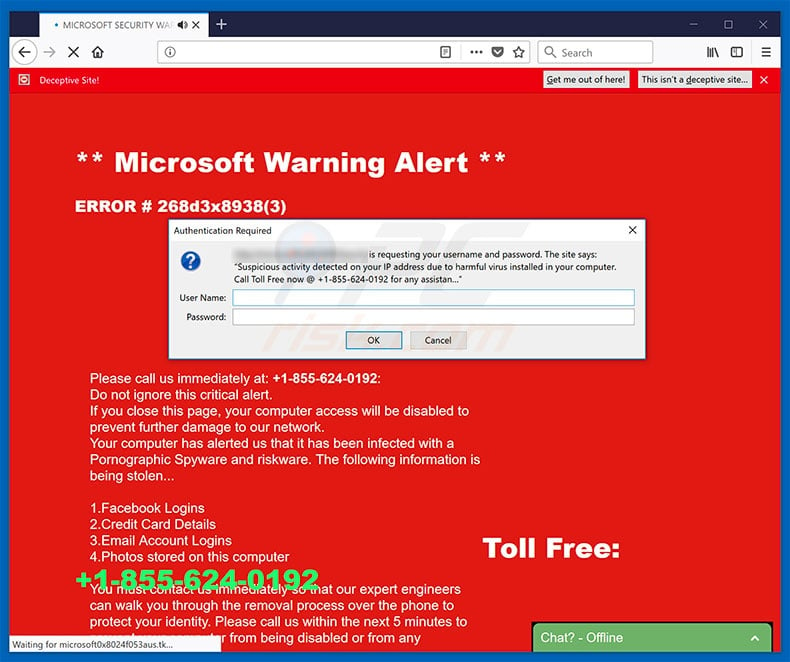
"ERROR 268d3x8938" scam overview
This error states that suspicious activity caused by a high-risk virus has been detected. The malware also supposedly poses a direct threat to personal information (logins/passwords, banking information, and so on) and must be eliminated immediately. Therefore, users are encouraged to contact 'tech support' via a toll-free telephone number ("+1-855-624-0192") provided.
This is a scam. "ERROR 268d3x8938" is fake and certainly has nothing to do with Microsoft. Cyber criminals generate revenue by tricking users into contacting fake tech support and paying for services that are not required. Your computer is likely to be completely virus-free. Therefore, ignore "ERROR 268d3x8938" and never call the aforementioned telephone number.
To remove this error, simply exit the web browser, however, some rogue sites use scripts that prevent users from closing browsing tabs/windows. In these cases, close the browser using Task Manager or simply reboot the system. After re-running the browser, do not restore the previous session, otherwise you will end up returning to the malicious site/s.
As mentioned above, potentially unwanted programs deliver various intrusive ads, such as banners, pop-ups, coupons, and so on. To achieve this, developers employ various tools that enable placement of third party graphical content on any site. Therefore, they are likely to conceal underlying content, significantly diminishing the browsing experience.
In addition, some ads redirect to malicious websites and even execute scripts that stealthily download and install PUPs/malware. Therefore, even a single click can result in high-risk computer infections. Another important issue is information tracking. Research shows that most PUPs gather data relating to browsing activity.
Recorded information (e.g., IP addresses, website URLs visited, pages viewed, etc.) is likely to contain personal details that developers share with third parties (potentially, cyber criminals). These people misuse private data to generate revenue.
Therefore, the presence of data-tracking app(s) can lead to serious privacy issues. For these reasons, uninstall all PUPs immediately.
| Name | "ERROR 268d3x8938" virus |
| Threat Type | Phishing, Scam, Social Engineering, Fraud |
| Fake Claim | The error messages claim that the system is infected and that users' personal data (account credentials, banking details, etc.) is at risk. For this reason, users are encouraged to contact tech support via provided telephone numbers. |
| Tech Support Scammer Phone Number | +1-855-624-0192, +1-844-869-9666 |
| Symptoms | Fake error messages, fake system warnings, pop-up errors, hoax computer scan. |
| Distribution methods | Compromised websites, rogue online pop-up ads, potentially unwanted applications. |
| Damage | Loss of sensitive private information, monetary loss, identity theft, possible malware infections. |
| Malware Removal (Windows) |
To eliminate possible malware infections, scan your computer with legitimate antivirus software. Our security researchers recommend using Combo Cleaner. Download Combo CleanerTo use full-featured product, you have to purchase a license for Combo Cleaner. 7 days free trial available. Combo Cleaner is owned and operated by RCS LT, the parent company of PCRisk.com. |
There are dozens of fake errors that have similar characteristics to "ERROR 268d3x8938". Bear in mind, however, that the actual purpose of all fake errors is to extort money from unsuspecting victims. Potentially unwanted programs are also known to share similarities.
By offering a wide range of "useful features", they attempt to give the impression of legitimacy, however, these programs, are designed only to generate revenue for the developers.
Rather than giving any real value for regular users, PUPs cause unwanted redirects, deliver intrusive advertisements, and gather sensitive information. In doing so, they pose a direct threat to your privacy and Internet browsing safety.
How did potentially unwanted programs install on my computer?
Some PUPs are known to have official download websites, however, due to the lack of knowledge and careless behavior of many users, these programs often infiltrate systems without permission.
Developers proliferate PUPs using intrusive advertisements and a deceptive marketing method called "bundling" (stealth installation of third party applications together with regular software/apps). Developers hide "bundled" apps within "Custom/Advanced" settings (or other sections) of the download/installation processes.
Furthermore, many users rush these procedures, skip steps, and click various advertisements without understanding the possible consequences. In doing so, they expose their systems to risk of various infections and compromise their privacy.
How to avoid installation of potentially unwanted applications?
This situation can be prevented by paying close attention when browsing the Internet and downloading/installing software. Bear in mind that intrusive advertisements usually seem legitimate, since developers invest many resources into their design, but most lead to untrustworthy sites such as pornography, gambling, adult dating, and so on.
If you encounter these ads, immediately eliminate all suspicious applications and browser plug-ins. Carefully analyze each window of the download/installation processes and opt-out of all additionally-included programs. You are advised to download your programs from official sources only, using direct download links.
Third party downloaders/installers are used to promote ("bundle") PUPs, and thus should never be used. The key to computer safety is caution. If your computer is already infected with PUPs, we recommend running a scan with Combo Cleaner Antivirus for Windows to automatically eliminate them.
Text presented in "ERROR 268d3x8938" pop-up:
Microsoft Warning Alert
ERROR # 268d3x8938(3)
"Suspicious activity detected on your IP address due to harmful virus installed in your computer. Call Toll Free now @ +1-855-624-0192 for any assistance..."
Please call us immediately at: +1-855-624-0192
Do not ignore this critical alert.
If you close this page, your computer access will be disabled to prevent further damage to our network.
Your computer has alerted is that it has been infected with a Pornographic Spyware and riskware. The following information is being stolen...
1. Facebook Logins
2. Credit Card Details
3. Email Account Logins
4. Photos stored on this computer.
You must contact us immediately so that our expert engineers can walk you through the removal process over the phone to protect your identity.
Please call us within the next 5 minutes.
The appearance of "ERROR 268d3x8938" pop-up (GIF):
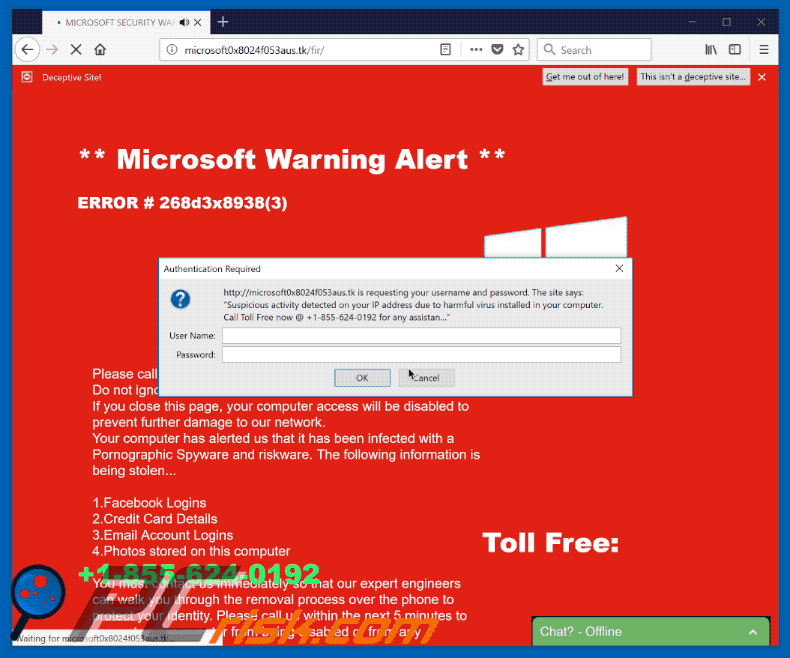
Another variant of "ERROR 268d3x8938" pop-up scam (the error message is virtually the same, the main difference is used telephone number - "+1-844-869-9666"):
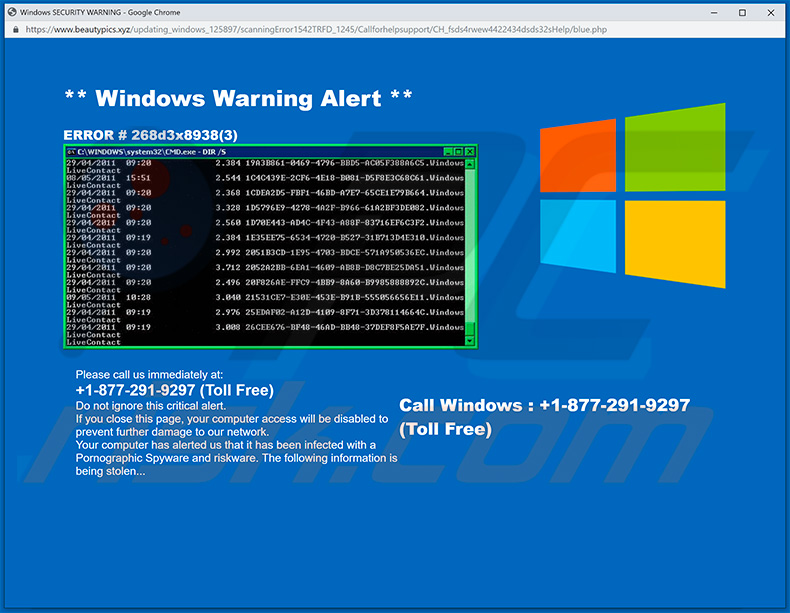
Text presented within this site:
** Windows Warning Alert **
ERROR # 268d3x8938(3)
Please call us immediately at: +1-844-869-9666.
Do not ignore this critical alert..
If you close this page, your computer access will be disabled to prevent further damage to our network. Your computer has alerted us that it has been infected with a Pornographic Spyware and riskware.The following information is being stolen:
1.Facebook Logins
2.Credit Card Details
3.Email Account Logins
4.Photos stored on this computer.
You must contact us immediately so that our expert engineers can walk you through the removal process over the phone to protect your identity. Please call us within the next 5 minutes to prevent your computer from being disabled or from any information loss.Toll Free:+1-844-869-9666
Appearance of this website (GIF):
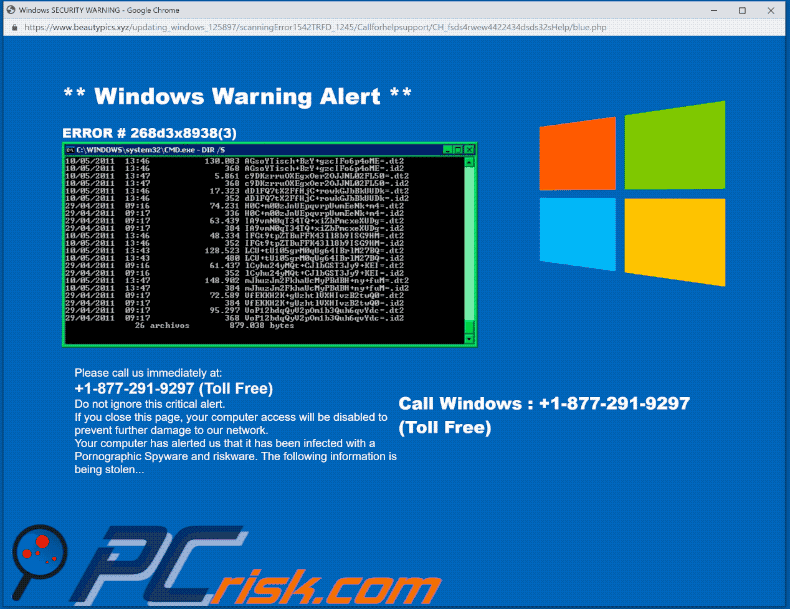
Appearance of the most recent "ERROR 268d3x8938" scam variant (May 22, 2020):
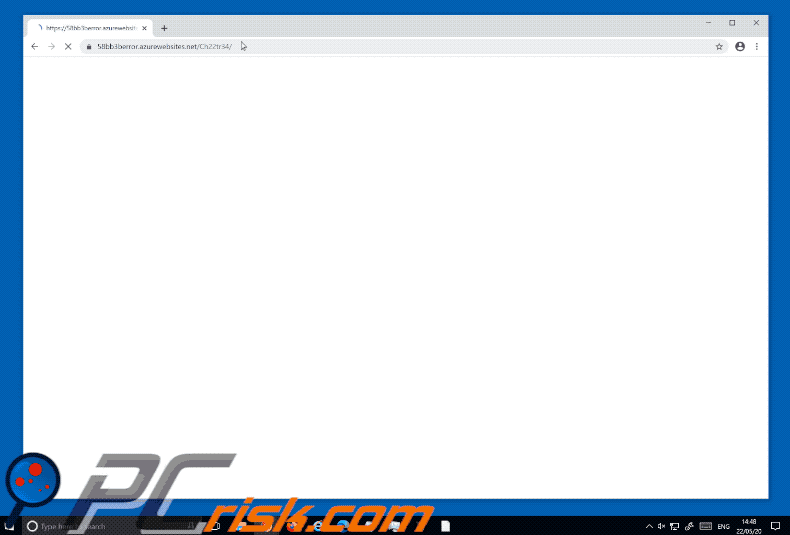
Another variant of "ERROR 268d3x8938" pop-up scam delivered using azurewebsites.net service:
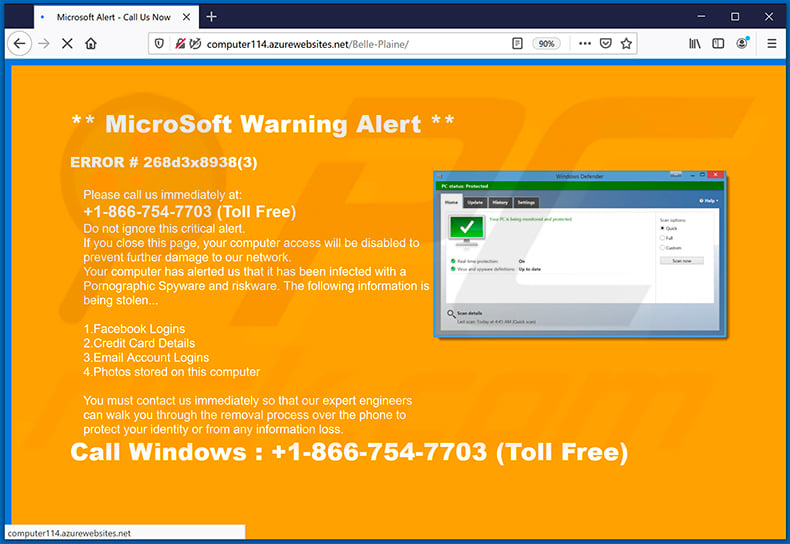
Text presented within:
** MicroSoft Warning Alert **
ERROR # 268d3x8938(3)
Please call us immediately at:
+1-866-754-7703 (Toll Free)
Do not ignore this critical alert.
If you close this page, your computer access will be disabled to prevent further damage to our network.
Your computer has alerted us that it has been infected with a Pornographic Spyware and riskware. The following information is being stolen...1.Facebook Logins
2.Credit Card Details
3.Email Account Logins
4.Photos stored on this computerYou must contact us immediately so that our expert engineers can walk you through the removal process over the phone to protect your identity or from any information loss.
Call Windows : +1-866-754-7703 (Toll Free)
Yet another variant of "" pop-up scam:
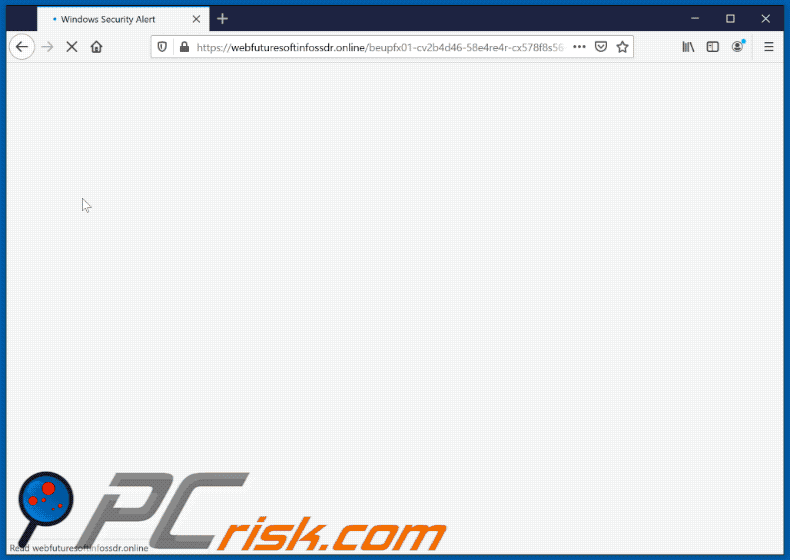
Text presented in the pop-up:
Suspicious movement distinguished on your IP address because of a spyware introduced in your PC. Call To Free now @ 0808-143-3684 for any help. Your information is at a Serious risk. There is a Computer framework record missing because of some Harmful malware infection Debug Malwareerror (code Ox80093acf) Call Immediately to correct the issue.Please do not Open web browser or make any changes for your Security Issue to avoid data loss & Corrupt systern files & drivers. Call immediately to save Hard disk Faure & Data loss. This Harmful malware is affecting your online information & can TrackFinancial Activity Contact Certified Technicians at 0808-143-3684.
Instant automatic malware removal:
Manual threat removal might be a lengthy and complicated process that requires advanced IT skills. Combo Cleaner is a professional automatic malware removal tool that is recommended to get rid of malware. Download it by clicking the button below:
DOWNLOAD Combo CleanerBy downloading any software listed on this website you agree to our Privacy Policy and Terms of Use. To use full-featured product, you have to purchase a license for Combo Cleaner. 7 days free trial available. Combo Cleaner is owned and operated by RCS LT, the parent company of PCRisk.com.
Quick menu:
- What is "ERROR 268d3x8938" virus?
- How to identify a pop-up scam?
- How do pop-up scams work?
- How to remove fake pop-ups?
- How to prevent fake pop-ups?
- What to do if you fell for a pop-up scam?
How to identify a pop-up scam?
Pop-up windows with various fake messages are a common type of lures cybercriminals use. They collect sensitive personal data, trick Internet users into calling fake tech support numbers, subscribe to useless online services, invest in shady cryptocurrency schemes, etc.
While in the majority of cases these pop-ups don't infect users' devices with malware, they can cause direct monetary loss or could result in identity theft.
Cybercriminals strive to create their rogue pop-up windows to look trustworthy, however, scams typically have the following characteristics:
- Spelling mistakes and non-professional images - Closely inspect the information displayed in a pop-up. Spelling mistakes and unprofessional images could be a sign of a scam.
- Sense of urgency - Countdown timer with a couple of minutes on it, asking you to enter your personal information or subscribe to some online service.
- Statements that you won something - If you haven't participated in a lottery, online competition, etc., and you see a pop-up window stating that you won.
- Computer or mobile device scan - A pop-up window that scans your device and informs of detected issues - is undoubtedly a scam; webpages cannot perform such actions.
- Exclusivity - Pop-up windows stating that only you are given secret access to a financial scheme that can quickly make you rich.
Example of a pop-up scam:

How do pop-up scams work?
Cybercriminals and deceptive marketers usually use various advertising networks, search engine poisoning techniques, and shady websites to generate traffic to their pop-ups. Users land on their online lures after clicking on fake download buttons, using a torrent website, or simply clicking on an Internet search engine result.
Based on users' location and device information, they are presented with a scam pop-up. Lures presented in such pop-ups range from get-rich-quick schemes to fake virus scans.
How to remove fake pop-ups?
In most cases, pop-up scams do not infect users' devices with malware. If you encountered a scam pop-up, simply closing it should be enough. In some cases scam, pop-ups may be hard to close; in such cases - close your Internet browser and restart it.
In extremely rare cases, you might need to reset your Internet browser. For this, use our instructions explaining how to reset Internet browser settings.
How to prevent fake pop-ups?
To prevent seeing pop-up scams, you should visit only reputable websites. Torrent, Crack, free online movie streaming, YouTube video download, and other websites of similar reputation commonly redirect Internet users to pop-up scams.
To minimize the risk of encountering pop-up scams, you should keep your Internet browsers up-to-date and use reputable anti-malware application. For this purpose, we recommend Combo Cleaner Antivirus for Windows.
What to do if you fell for a pop-up scam?
This depends on the type of scam that you fell for. Most commonly, pop-up scams try to trick users into sending money, giving away personal information, or giving access to one's device.
- If you sent money to scammers: You should contact your financial institution and explain that you were scammed. If informed promptly, there's a chance to get your money back.
- If you gave away your personal information: You should change your passwords and enable two-factor authentication in all online services that you use. Visit Federal Trade Commission to report identity theft and get personalized recovery steps.
- If you let scammers connect to your device: You should scan your computer with reputable anti-malware (we recommend Combo Cleaner Antivirus for Windows) - cyber criminals could have planted trojans, keyloggers, and other malware, don't use your computer until removing possible threats.
- Help other Internet users: report Internet scams to Federal Trade Commission.
Frequently Asked Questions (FAQ)
What is a pop-up scam?
Pop-up scams are deceptive messages intended to trick users into performing specific actions. For example, victims can be enticed into calling fake support lines, allowing cyber criminals to access devices remotely, downloading/installing programs, sending money to scammers, purchasing products, subscribing to services, and so on.
What is the purpose of a pop-up scam?
Pop-up scams are designed to generate revenue for scammers. Profit can be made by acquiring funds through deception, promoting content (e.g., websites, software, products, services, etc.), selling/abusing private data, and proliferating malware.
Why do I encounter fake pop-ups?
Pop-up scams are most commonly promoted via websites using rogue advertising networks, malvertising (intrusive ads), spam (e.g., emails, SMSes, PMs/DMs, social media/ forum posts, browser notifications, etc.), typosquatting (misspelled URLs), and adware.
I cannot exit a scam page, how do I close it?
If you cannot close a scam page – end the browser's process using Task Manager. Remember to begin a new browsing session when relaunching the browser since restoring the old one will reopen the deceptive website.
I have allowed cyber criminals to remotely access my computer, what should I do?
If you have allowed cyber criminals to access your device remotely – you must first disconnect it from the Internet. Afterward, remove the remote access program that the criminals used (e.g., UltraViewer, TeamViewer, etc.), as they might not need your consent to reconnect. Lastly, perform a full system scan and eliminate all detected threats.
I have provided my personal information when tricked by a pop-up scam, what should I do?
If you have provided your log-in credentials – change the passwords of all possibly exposed accounts and inform their official support without delay. However, if you've disclosed other private information (e.g., ID card details, passport scans/photos, credit/debit card numbers, etc.) – immediately contact the appropriate authorities.
Will Combo Cleaner protect me from pop-up scams and the malware they proliferate?
Combo Cleaner can scan visited websites and detect rogue, deceptive, and malicious pages. It can also restrict further access to such webpages. Additionally, Combo Cleaner can detect and eliminate most of the known malware infections. Keep in mind that performing a full system scan is essential since sophisticated malicious programs typically hide deep within systems.
Share:

Tomas Meskauskas
Expert security researcher, professional malware analyst
I am passionate about computer security and technology. I have an experience of over 10 years working in various companies related to computer technical issue solving and Internet security. I have been working as an author and editor for pcrisk.com since 2010. Follow me on Twitter and LinkedIn to stay informed about the latest online security threats.
PCrisk security portal is brought by a company RCS LT.
Joined forces of security researchers help educate computer users about the latest online security threats. More information about the company RCS LT.
Our malware removal guides are free. However, if you want to support us you can send us a donation.
DonatePCrisk security portal is brought by a company RCS LT.
Joined forces of security researchers help educate computer users about the latest online security threats. More information about the company RCS LT.
Our malware removal guides are free. However, if you want to support us you can send us a donation.
Donate
▼ Show Discussion